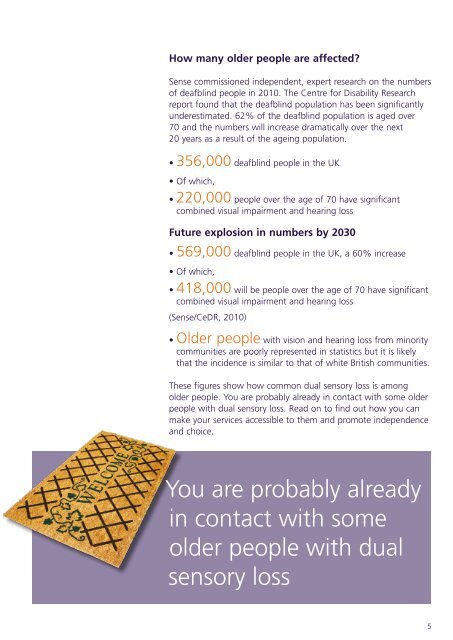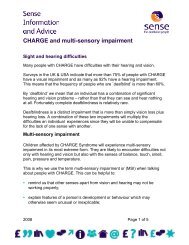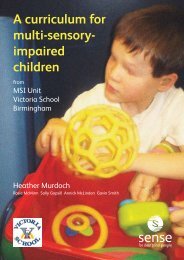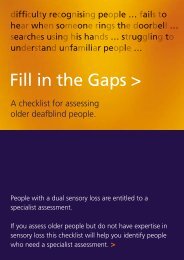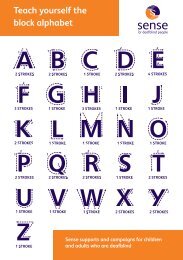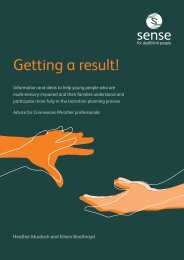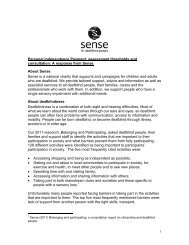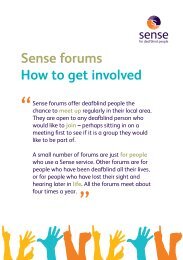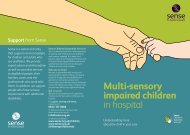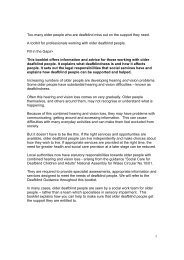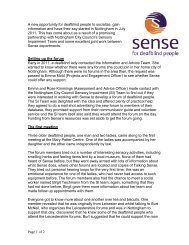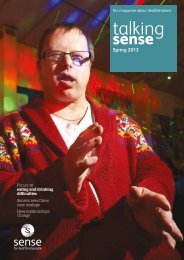Fill in the Gaps > Too many older people who are deafblind ... - Sense
Fill in the Gaps > Too many older people who are deafblind ... - Sense
Fill in the Gaps > Too many older people who are deafblind ... - Sense
Create successful ePaper yourself
Turn your PDF publications into a flip-book with our unique Google optimized e-Paper software.
How <strong>many</strong> <strong>older</strong> <strong>people</strong> <strong>are</strong> affected?<strong>Sense</strong> commissioned <strong>in</strong>dependent, expert research on <strong>the</strong> numbersof deafbl<strong>in</strong>d <strong>people</strong> <strong>in</strong> 2010. The Centre for Disability Researchreport found that <strong>the</strong> deafbl<strong>in</strong>d population has been significantlyunderestimated. 62% of <strong>the</strong> deafbl<strong>in</strong>d population is aged over70 and <strong>the</strong> numbers will <strong>in</strong>crease dramatically over <strong>the</strong> next20 years as a result of <strong>the</strong> age<strong>in</strong>g population.• 356,000 deafbl<strong>in</strong>d <strong>people</strong> <strong>in</strong> <strong>the</strong> UK• Of which,• 220,000 <strong>people</strong> over <strong>the</strong> age of 70 have significantcomb<strong>in</strong>ed visual impairment and hear<strong>in</strong>g lossFuture explosion <strong>in</strong> numbers by 2030• 569,000 deafbl<strong>in</strong>d <strong>people</strong> <strong>in</strong> <strong>the</strong> UK, a 60% <strong>in</strong>crease• Of which,• 418,000 will be <strong>people</strong> over <strong>the</strong> age of 70 have significantcomb<strong>in</strong>ed visual impairment and hear<strong>in</strong>g loss(<strong>Sense</strong>/CeDR, 2010)• Older <strong>people</strong> with vision and hear<strong>in</strong>g loss from m<strong>in</strong>oritycommunities <strong>are</strong> poorly represented <strong>in</strong> statistics but it is likelythat <strong>the</strong> <strong>in</strong>cidence is similar to that of white British communities.These figures show how common dual sensory loss is among<strong>older</strong> <strong>people</strong>. You <strong>are</strong> probably already <strong>in</strong> contact with some <strong>older</strong><strong>people</strong> with dual sensory loss. Read on to f<strong>in</strong>d out how you canmake your services accessible to <strong>the</strong>m and promote <strong>in</strong>dependenceand choice.You <strong>are</strong> probably already<strong>in</strong> contact with some<strong>older</strong> <strong>people</strong> with dualsensory loss5


